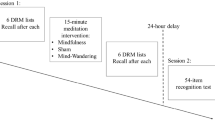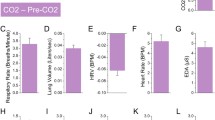Abstract
Individuals with panic disorder (n = 14) and normal controls (n = 14) performed two different memory tasks: a high-speed recognition task that measured perceptual memory (memory for the sensory/perceptual features of a stimulus) and a free recall task that measured semantic memory (memory for the meaning associated with the stimulus). Subjects' memory for threatening, positive, and neutral words was evaluated. In contrast to normal controls, panic disorder patients showed better perceptual memory and better semantic memory for threat words compared to positive and neutral words. These results suggest that the panic disorder individuals engaged in preferential processing of threat information at both a perceptual and semantic level of analysis. The results do not support a “cognitive avoidance” hypothesis which predicts the inhibition of more elaborate and meaningful processing of threat stimuli in anxious subjects. The conditions under which cognitive avoidance might occur are outlined.
Similar content being viewed by others
References
American Psychiatric Association (1987).Diagnostic and statistical manual of mental disorders (3rd ed., revised). Washington, DC: Author.
Barlow, D. H., Craske, M. G., Cerny, J. A., & Klosko, J. S. (1989). Behavioral treatment of panic disorder.Behavior Therapy, 20 261–282.
Beck, A. T., & Emery, G. (1985).Anxiety disorders and phobias: A cognitive perspective. New York: Basic Books.
Beck, A. T., Ward, C. H., Mendelson, M., Mock, J., & Erbaugh J. (1961). An inventory for measuring depression.Archives of General Psychiatry, 4 561–571.
Bower, G. H. (1981). Mood and memory.American Psychologist, 36 129–148.
Bower, G. H. (1987). Commentary on mood and memory.Behaviour Research and Therapy, 25 443–455.
Burgess, I. S., Jones, L. M., Robertson, S. A., Radcliffe, W. N., & Emerson, E. (1981). The degree of control exerted by phobic and nonphobic verbal stimuli over the recognition behavior of phobic and non-phobic subjects.Behaviour Research and Therapy, 19 233–243.
Clark, D. M. (1986). A cognitive approach to panic.Behaviour Research and Therapy, 24 461–470.
Craik, F. I. M., & Lockhart, R. S. (1972). Levels of processing: A framework for memory research.Journal of Verbal Learning and Verbal Behavior, 11 671–684.
Craik, F. I. M., & Tulving, E. (1975). Depth of processing and the retention of words in episodic memory.Journal of Experimental Psychology: General, 104 268–294.
Ehlers, A., Margraf, J., Davies, S., & Roth, W. T. (1988). Selective processing of threat cues in subjects with panic attacks.Cognition and Emotion, 2 201–219.
Foa, E. B., & Kozak, M. J. (1986). Emotional processing of fear: Exposure to corrective information.Psychological Bulletin, 99 20–35.
Foa, E. B., & McNally, R. J. (1986). Sensitivity to feared stimuli in obsessive-compulsives: A dichotic listening analysis.Cognitive Therapy and Research, 10 477–485.
Folstein, M. F., & Luria, R. (1973). Reliability, validity, and clinical application of the visual analogue mood scale.Psychological Medicine, 3 479–486.
Glaser, D. (1988).React [Computer program in the public domain].
Graf, P., & Mandler, G. (1984). Activation makes words more accessible but not necessarily more retrievable.Journal of Verbal Learning and Verbal Behavior, 23 553–568.
Grayson, J. B., & Borkovec, T. D. (1978). The effects of expectancy and imagined response to phobic stimuli on fear reduction.Cognitive Therapy and Research, 2 11–24.
Hope, D. A., Rapee, R. M., Heimberg, R. G., & Dombeck, M. (1990). Representations of the self in social phobia: Vulnerability to social threat.Cognitive Therapy and Research, 14 177–189.
Jacoby, L. L., & Dallas, M. (1981). On the relationship between autobiographical memory and perceptual learning.Journal of Experimental Psychology: General, 110 306–340.
Johnson, M. K. (1983). A multiple entry, modular memory system. In G. H. Bower (Ed.),The psychology of learning and motivation (Vol. 17, pp. 81–123). New York: Academic Press.
Johnson, M. K., Kim, J. K., & Risse, G. (1985). Do alcoholic Korsakoff syndrome patients acquire affective reactions?Journal of Experimental Psychology: Learning, Memory and Cognition, 11 3–11.
Kucera, H., & Francis, W. N. (1967).Computational analysis of present-day American English. Providence, RI: Brown University Press.
MacLeod, C., & Mathews, A. (1988). Anxiety and the allocation of attention to threat.Quarterly Journal of Experimental Psychology-Section A, 40A 653–670.
MacLeod, C., Mathews, A., & Tata, P. (1986). Attentional bias in emotional disorders.Journal of Abnormal Psychology, 95 131–138.
Martin, M., Williams, R., & Clark, D. M. (1991). Does anxiety lead to selective processing of threat-related information?Behaviour Research and Therapy, 29 147–160.
Mathews A., & MacLeod, C. (1985). Selective processing of threat cues in anxiety states.Behaviour Research and Therapy, 23 563–569.
Mathews, A., & MacLeod, C. (1986). Discrimination of threat cues without awareness in anxiety states.Journal of Abnormal Psychology, 95 131–138.
Mathews, A., Mogg, K., May, J., & Eysenck, M. (1989). Implicit and explicit memory bias in anxiety.Journal of Abnormal Psychology, 98 236–240.
McNally, R. J., Foa, E. B., & Donnell, C. D. (1989). Memory bias for anxiety information in patients with panic disorder.Cognition and Emotion, 3 27–44.
McNally, R. J., Riemann, B. C., & Kim, E. (1990). Selective processing of threat cues in panic disorder.Behaviour Research and Therapy, 28 407–412.
Mogg, K., Mathews, A., & Weinman, J. (1987). Memory bias in clinical anxiety.Journal of Abnormal Psychology, 96 94–98.
Mogg, K., Mathews, A., & Weinman, J. (1989). Selective processing of threat cues in anxiety states: A replication.Behaviour Research and Therapy, 27 317–323.
Neisser, U. (1976).Cognition and reality: Principles and implications of cognitive psychology. San Francisco: W. H. Freeman.
Parkinson, L., & Rachman, S. (1981) Intrusive thoughts: The effects of an uncontrived stress.Advances in Behaviour Research and Therapy, 3 111–118.
Roediger, H. L., III, Weldon, M. S., & Challis, B. H. (1989). Explaining dissociations between implicit and explicit measures of retention: A processing account. In H. L. Roediger & F. I. M. Craik (Eds.),Varieties of memory and consciousness: Essays in honour of Endel Tulving (pp. 3–41). Hillsdale, NJ: Erlbaum.
Schuberth, R. F., & Eimas, P. (1977). Effects of context on the classification of words and nonwords.Journal of Experimental Psychology: Human Perception and Performance, 3 27–36.
Shipley, W. P. (1939).Shipley Institute of Living Scale for Measuring Intellectual Impairment: Manual for directions and scoring. Hartford, CT: Institute of Living.
Spielberger, C. D., Gorsuch, R. L., & Lushene, R. E. (1970).Manual for the State-Trait Anxiety Inventory. Palo Alto, CA: Consulting Psychologists Press.
Spitzer, R. L., Williams, J. B. W., & Gibbon, M. (1987).Structured Clinical Interview for DSM-III-R New York: Biometrics Research Department, New York State Psychiatric Institute.
Watts, F. N., Trezise, L., & Sharrock, R. (1986). Processing of phobic stimuli.British Journal of Clinical Psychology, 25 253–259.
Williams, J. M. G., Watts, F. N., MacLeod, C., & Mathews, A. (1988).Cognitive psychology and emotional disorders. Chichester: Wiley.
Author information
Authors and Affiliations
Additional information
The authors would like to thank Rick Heimberg, Craig Holt, and Debra Holt for their helpful comments on earlier drafts of this paper as well as Diane Arnkoff and two anonymous reviewers.
Rights and permissions
About this article
Cite this article
Cloitre, M., Liebowitz, M.R. Memory bias in panic disorder: An investigation of the cognitive avoidance hypothesis. Cogn Ther Res 15, 371–386 (1991). https://doi.org/10.1007/BF01173032
Issue Date:
DOI: https://doi.org/10.1007/BF01173032




